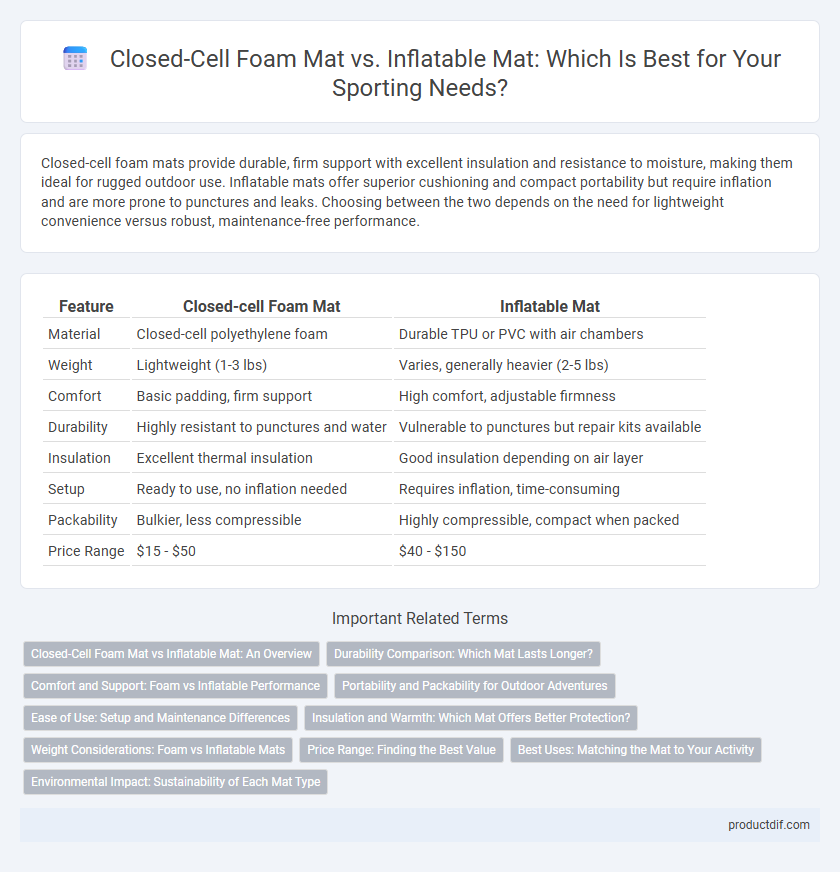Closed-cell foam mats provide durable, firm support with excellent insulation and resistance to moisture, making them ideal for rugged outdoor use. Inflatable mats offer superior cushioning and compact portability but require inflation and are more prone to punctures and leaks. Choosing between the two depends on the need for lightweight convenience versus robust, maintenance-free performance.
Table of Comparison
| Feature | Closed-cell Foam Mat | Inflatable Mat |
|---|---|---|
| Material | Closed-cell polyethylene foam | Durable TPU or PVC with air chambers |
| Weight | Lightweight (1-3 lbs) | Varies, generally heavier (2-5 lbs) |
| Comfort | Basic padding, firm support | High comfort, adjustable firmness |
| Durability | Highly resistant to punctures and water | Vulnerable to punctures but repair kits available |
| Insulation | Excellent thermal insulation | Good insulation depending on air layer |
| Setup | Ready to use, no inflation needed | Requires inflation, time-consuming |
| Packability | Bulkier, less compressible | Highly compressible, compact when packed |
| Price Range | $15 - $50 | $40 - $150 |
Closed-Cell Foam Mat vs Inflatable Mat: An Overview
Closed-cell foam mats offer superior durability, insulation, and puncture resistance compared to inflatable mats, making them ideal for rugged outdoor activities and prolonged use. Inflatable mats provide enhanced comfort and compactness, as they can be deflated and packed smaller, but they are more susceptible to leaks and require inflation effort. The choice between closed-cell foam and inflatable mats depends on prioritizing either lightweight portability and cushioning or robust protection and thermal insulation.
Durability Comparison: Which Mat Lasts Longer?
Closed-cell foam mats offer superior durability due to their dense, non-porous structure that resists punctures, abrasions, and environmental wear, making them ideal for rugged outdoor use. Inflatable mats are more susceptible to punctures and leaks, which can significantly reduce their lifespan despite providing better cushioning and portability. For long-term durability and reliability, closed-cell foam mats typically outlast inflatable mats under consistent use and rough conditions.
Comfort and Support: Foam vs Inflatable Performance
Closed-cell foam mats provide consistent comfort and reliable support by maintaining their shape and firmness regardless of external pressure, making them ideal for rugged outdoor use. Inflatable mats offer customizable firmness and enhanced cushioning by adjusting air pressure, which improves comfort on uneven terrain but may risk punctures and require maintenance. The choice between foam and inflatable mats depends on the need for durability and low weight versus adjustable comfort and packability in sporting gear.
Portability and Packability for Outdoor Adventures
Closed-cell foam mats offer superior portability and packability for outdoor adventures due to their lightweight, durable design and ability to fold compactly without risk of punctures or leaks. Inflatable mats provide excellent cushioning and comfort but require more careful handling and time for inflation, making them less convenient for quick packing or rough terrain. Choosing between the two depends on prioritizing ease of transport and durability versus comfort and compactness.
Ease of Use: Setup and Maintenance Differences
Closed-cell foam mats offer quick, hassle-free setup as they require no inflation or deflation, making them ideal for spontaneous outings and low-maintenance use. Inflatable mats demand more time and effort for setup, involving careful inflation, but they provide customizable firmness for enhanced comfort. Maintenance-wise, closed-cell foam mats resist punctures and require minimal care, while inflatable mats need regular inspections for leaks and occasional repairs to maintain optimal performance.
Insulation and Warmth: Which Mat Offers Better Protection?
Closed-cell foam mats provide superior insulation due to their dense structure that traps air and blocks moisture, making them highly effective for warmth in cold conditions. Inflatable mats rely on trapped air to insulate, but they can lose heat if punctured or inadequately inflated, resulting in less reliable warmth. For consistent protection against cold terrain, closed-cell foam mats generally offer better insulation and durability compared to inflatable models.
Weight Considerations: Foam vs Inflatable Mats
Closed-cell foam mats typically weigh more than inflatable mats due to their dense material composition but offer consistent insulation and durability. Inflatable mats provide a lighter, more compact option ideal for backpacking, although they require inflation and are more vulnerable to punctures. Choosing between the two depends on prioritizing weight savings or impact resistance and ease of maintenance during outdoor activities.
Price Range: Finding the Best Value
Closed-cell foam mats typically offer a lower price range, making them an affordable choice for budget-conscious outdoor enthusiasts seeking durability and insulation. Inflatable mats tend to be more expensive due to their lightweight design and superior packability, appealing to those prioritizing comfort and portability. Evaluating the balance between cost and features helps find the best value based on individual camping or sporting needs.
Best Uses: Matching the Mat to Your Activity
Closed-cell foam mats provide excellent insulation and durability, making them ideal for rugged activities like backpacking and mountaineering where protection against rough terrain is essential. Inflatable mats offer superior comfort and compactness, best suited for car camping or lightweight hiking where packability and sleeping comfort are priorities. Choosing between these mats depends on balancing the need for durability and insulation against portability and sleeping comfort specific to your outdoor activity.
Environmental Impact: Sustainability of Each Mat Type
Closed-cell foam mats are typically made from non-biodegradable materials like EVA or polyethylene, leading to longer decomposition times and greater environmental persistence. Inflatable mats, often constructed from PVC or TPU, can be more sustainable if designed for durability and repairability, reducing the need for frequent replacement. Recycling options remain limited for both types, but innovations in eco-friendly materials and manufacturing processes are improving the overall sustainability profile of inflatable mats compared to traditional foam counterparts.
Closed-cell foam mat vs Inflatable mat Infographic

 productdif.com
productdif.com